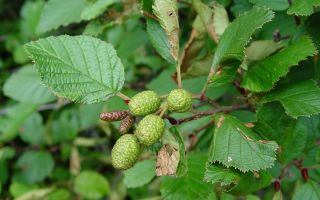Content
The beneficial properties of alder are of interest to connoisseurs of traditional medicine. The buds, cones and other parts of the plant help to heal many diseases.
Description of the alder tree and where it grows
Alder is a deciduous tree or shrub from the Birch family, reaching 5 m in height. It has a smooth grayish bark, alternate rounded or ovoid leaves with teeth along the edge. In March and April, the plant bears inflorescences - long staminate in the form of earrings and short oval pistillate. In September and October, female flowers grow, stiffen and form seedlings, or cones, that can remain on the branches all winter.
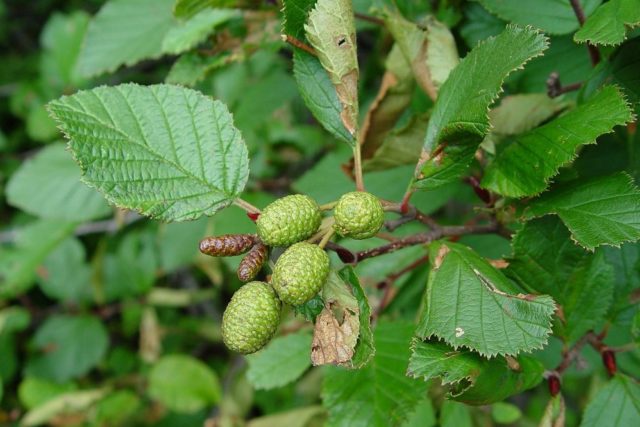
Alder can be seen everywhere in the temperate climate of the Northern Hemisphere. Some species grow in Asia and North Vietnam, South America. Most often, the tree is found in damp places, near water bodies, on river banks, in mixed and coniferous forests.
Chemical composition
The buds, pollen, bark and cones of the plant contain a huge amount of nutrients. Alder contains:
- essential oils;
- tannins and organic acids;
- flavone glycosides;
- tannins;
- alkaloids;
- taraxerol and triterpenoids;
- caffeic and protocatechic acid;
- alnulin;
- fatty oils and steroids.
When used according to recipes, the alder plant has very beneficial effects on the body and helps with many diseases.
Why is alder useful for human health?
Preparations based on plant materials obtained from alder are used:
- to normalize digestion and metabolism;
- to eliminate bleeding and wound healing;
- as a diaphoretic;
- to cleanse the blood;
- for pain relief;
- to eliminate diarrhea;
- with inflammation and bacterial processes;
- with colds;
- to combat skin fungi;
- in the treatment of hemorrhoids, constipation, dysentery;
- with gastritis, colitis and stomach ulcers.
The properties of alder in medicine are used for joint ailments, skin irritation and allergies. The plant is also used in cosmetology, products based on it help well to reduce the oily hair and get rid of dandruff.
Medicinal properties of earrings, buds, alder pollen
Tree catkins and short female buds of the plant are especially highly valued in folk medicine. From them, infusions and decoctions are prepared, which help with enteritis and colitis, bloating and pain. You can use the healing properties of alder inflorescences to create diaphoretic agents.
The pollen of the tree has valuable melliferous qualities.In folk medicine, it is used for colds, rheumatism and gout, for violations of the intestinal microflora and food poisoning.
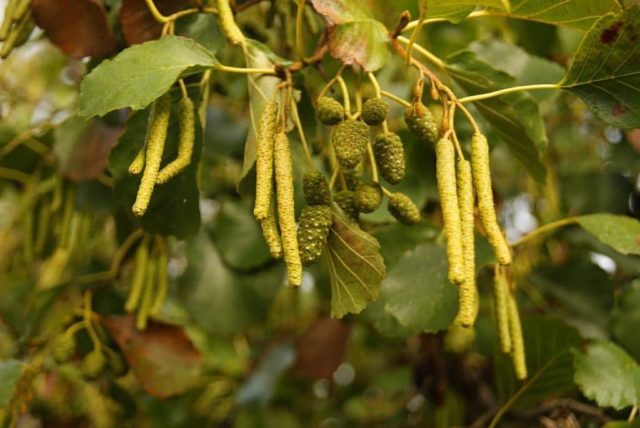
Tree cones are also a valuable natural product. They contain a lot of tannins, so the raw materials of the plant are used to stop bleeding and in the treatment of inflammatory diseases.
The healing properties of the bark, alder wood
In folk medicine, the properties and benefits of black alder and gray varieties are used. The bark and young twigs are suitable for the treatment of digestive, colds and gynecological inflammatory diseases. Usually, strong tinctures or decoctions are prepared from the woody parts of the plant, in which the maximum amount of valuable tannins is preserved.
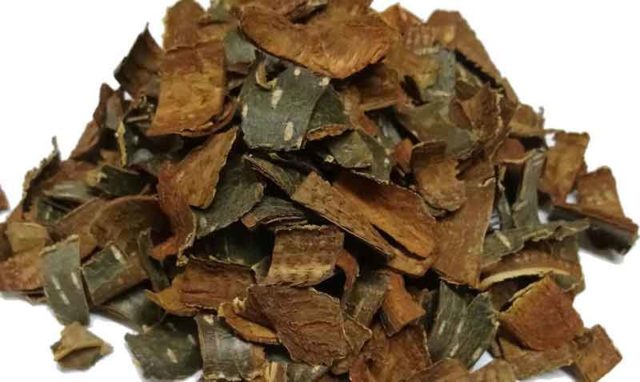
Useful properties of alder leaves
Tinctures and decoctions based on the leaves have a laxative effect; drugs can be used for chronic constipation. Also, alder plates are good at reducing fever in case of colds.
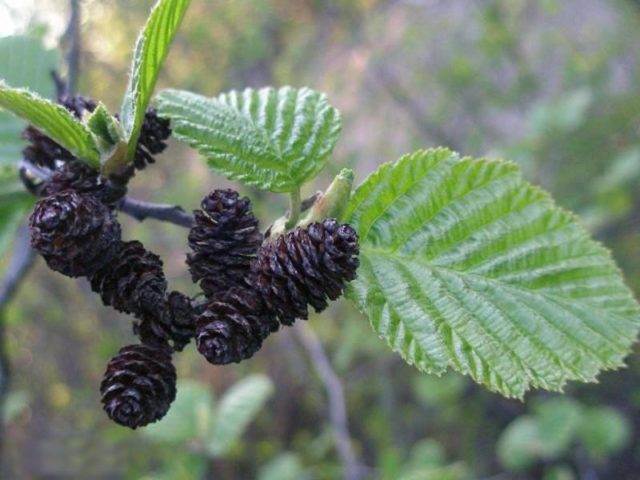
The benefits of an alder broom for a bath
Healing brooms for a bath are made from thin tree branches. First of all, such bundles perfectly massage the body due to the abundant leaves. In addition, in a steam room, alder, under the influence of humidity and high temperature, releases useful bactericidal substances and essential oils. A broom can be used for respiratory diseases, skin ailments and inflammation of the joints. In the bath, alder will benefit from increased skin oily, acne and ulcers, with excessive sweating.
Preparation and application methods
Traditional medicine offers several options for processing alder fruits, kidneys and other parts. Any means have a good healing effect.
Tincture
The recipe for the tincture is as follows:
- 100 g of seed fruits of the tree are poured into a glass container;
- pour 500 ml of alcohol or high-quality vodka;
- the bottle is closed and sent to a dark place for two weeks.
At the end of the period, the tincture is filtered from the sediment. You need to take the remedy 25-40 drops, depending on the disease, three times a day. Alder tincture brings a good effect for colds and inflammatory ailments, for intestinal disorders.
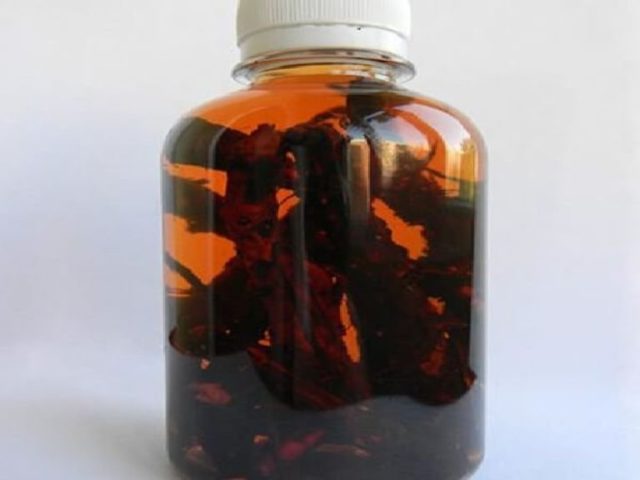
Infusion
Alder buds and earrings are used to prepare an aqueous infusion. The recipe looks like this:
- two large spoons of raw materials are ground into small crumbs;
- pour a glass of hot water;
- kept closed for half an hour;
- filtered.
The filtered alder infusion is taken in a large spoonful three times a day on a full stomach.
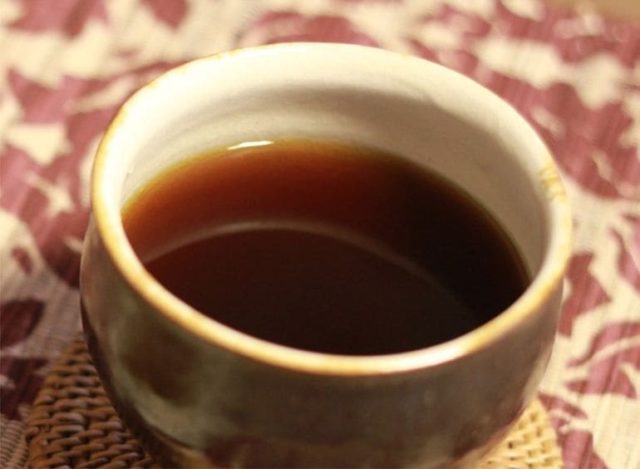
Decoction
Alder bark is beneficial for diarrhea due to its high tannin content. Prepare the drug as follows:
- two large spoons of bark are crushed;
- pour 300 ml of boiling water;
- keep in a water bath for about 20 minutes;
- removed from the stove and insisted in a warm place for another four hours.
You need to consume alder broth three times a day, only 10 ml on an empty stomach.
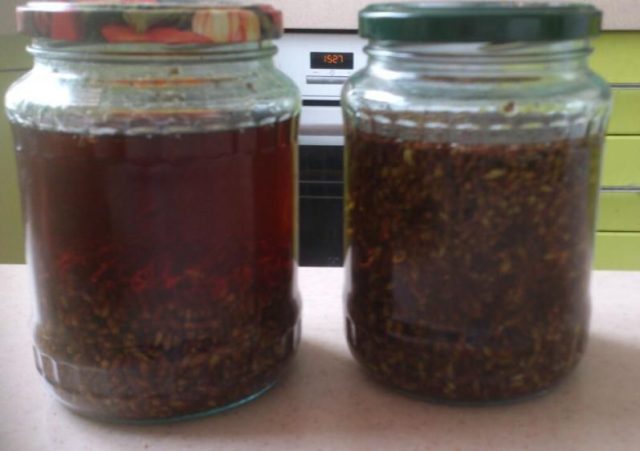
Application in traditional medicine
Most often, the medicinal properties of alder are used to treat digestive disorders. When used in prescription form, the plant helps to relieve stomach discomfort and improve metabolic processes.
With heaviness and pain in the abdomen
With pain in the epigastric region, an infusion of alder buds and inflorescences helps well. They do it like this:
- 5 g of plant raw materials are poured with 200 ml of hot water;
- cover the container with a lid;
- incubated at room temperature for three hours.
The filtered alder infusion should be drunk four times a day, 50 ml each until the condition improves.
With diarrhea and dysentery
A decoction of alder bark or kidneys helps to cope with indigestion. Do it as follows:
- 100 g of raw alder is poured with 500 ml of hot water;
- simmer over low heat for 15 minutes;
- cool in a warm place for another three hours.
Then the product must be passed through cheesecloth for filtration. They drink a decoction of alder, 100 ml twice a day, it can also be used for colds, arthritis and malaria.
With chronic colitis
With intestinal colitis, an alcoholic tincture of the plant is beneficial. They do it like this:
- 100 g of inflorescences and cones are poured with 500 ml of vodka or alcohol;
- for five days they are removed to a dark place, not forgetting to shake the vessel daily;
- pass the tincture through folded gauze for filtration.
The remedy is taken 25 drops three times a day, the medicine is preliminarily diluted in a small amount of water.
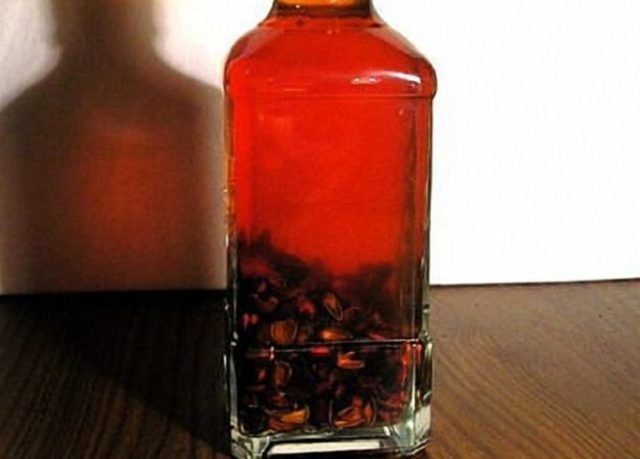
With thrombophlebitis
With varicose veins and a tendency to form blood clots, a prefabricated infusion with the use of alder seedlings is beneficial. They make it according to this recipe:
- raw alder is mixed in equal proportions with plantain, celandine, succession and fir;
- add the same amount of willow bark, lilac, woodruff, podbelo and mullein;
- measure 10 g of healing collection;
- pour 200 ml of hot water;
- insist three hours in a dark place.
The resulting preparation is filtered and divided into three equal portions, and then consumed during the day every time after meals. You need to take alder infusion daily for two months, at the same time you can make lotions for problem areas with the same remedy.
With hemorrhoids
The healing properties of alder are beneficial for external hemorrhoids. It is recommended to take daily sitz baths based on inflorescences and buds. Prepare the following healing collection:
- 10 g of alder is mixed with equal amounts of sage, wheatgrass and oregano;
- add the same amount of whitewash and linden;
- brew a large spoonful of collecting 1 liter of hot water;
- stand for about half an hour.
The filtered product is poured into a large basin of hot water and lowered into it with the lower body for 15 minutes. It is necessary to repeat the procedure in the evenings for a month to obtain a permanent effect.
Application in cosmetology
Alder seedlings are used in home cosmetology. Decoctions and infusions based on the plant promote hair growth and stop hair loss, reduce oily curls and eliminate dandruff. They can be used to treat irritated skin, to tighten pores, and to treat acne.
With increased greasiness of the epidermis and frequent rashes, such a remedy gives a good effect:
- a large spoonful of seed fruits is crushed;
- plant raw materials are poured with 300 ml of boiling water;
- kept closed for two hours and filtered.
It is necessary to use the infusion for washing up to three times a day, the procedure must be repeated daily.
Alder inflorescences have a good effect on brittle hair that is prone to loss. For medicinal purposes, a simple remedy should be prepared:
- three large spoons of seed fruits and plant buds are poured into a thermos;
- raw materials are poured with 500 ml of boiling water;
- insist for three hours;
- passed through folded gauze.
Healing alder infusion must be rubbed into the root area daily, shortly before bedtime. It is not necessary to remove the product after application. In total, the procedure is repeated for ten days, at the same time it is recommended to use the infusion for rinsing every time after the usual shampooing.
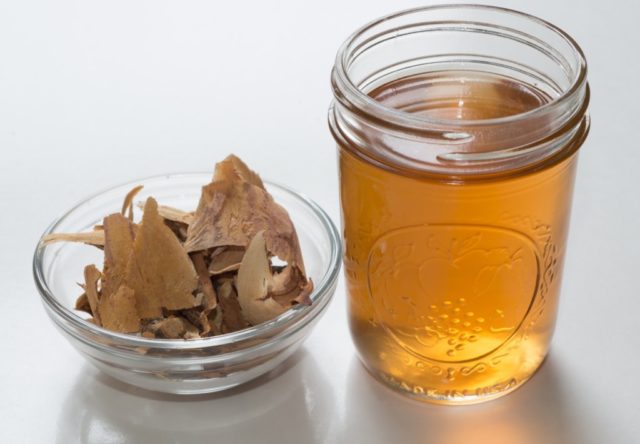
Contraindications to the use of alder
The health benefits and harms of alder are individual, the plant has certain contraindications. These include:
- pregnancy and lactation;
- children under 12 years old;
- individual intolerance to plant materials;
- stomach ulcer and gastritis in the acute stage;
- pancreatitis in the acute phase.
Since the bark and cones of the plant have anchoring properties, it is not recommended to use them with a tendency to constipation. With frequent diarrhea, care should be taken when using the leaves. Also, during treatment with alder raw materials, the dosages indicated in the recipes must be carefully observed.
Against the background of exceeding the volume of drugs, side effects may develop - nausea, dizziness and migraine. In this case, the use of infusions and decoctions should be stopped immediately, and if symptoms persist, consult a doctor.
Collection and procurement
The timing of the collection of raw materials varies depending on which parts of the alder are required for medicinal purposes. Plant cones are harvested in late autumn or early winter, annual shoots about 1.5 cm long are cut with pruning shears. At the same time, it is not recommended to touch ordinary young branches, flower buds are formed on them, which are just about to bloom in the spring.
Alder earrings and pollen are harvested in the spring during the flowering period. The leaves of the plant are best harvested before the beginning of summer, when they contain a maximum of vitamins and organic acids. Alder bark is removed before the spring vegetation or in the fall shortly before the cold weather, when the tree is dormant and will not suffer from damage.
Plant materials can be used immediately after harvest. But more often alder is dried for long-term storage. To do this, parts of the plant are laid out in a thin layer on a flat surface in a warm room or outdoors, away from direct sun, but with good ventilation. During the drying process, the raw materials are agitated from time to time. Also, to evaporate moisture, you can use electric dryers or ovens, heating them no more than 50 ° C.
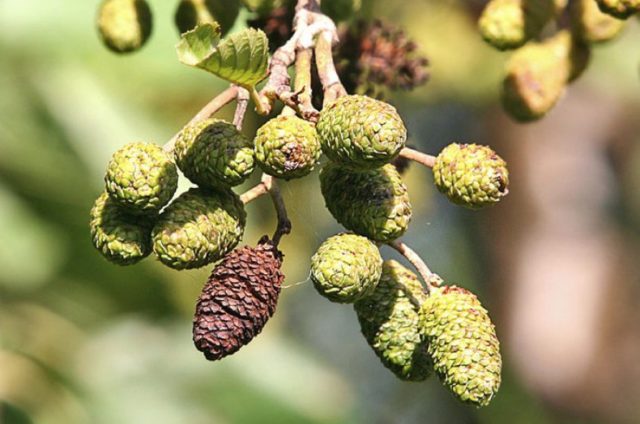
Store alder in paper bags, wooden boxes, or cloth bags. The place is chosen dark, moderately warm and dry, without access to sunlight. The useful properties of the workpiece are retained for three years, and after that a new collection of the plant is required.
Conclusion
The beneficial properties of alder are widely used in folk medicine. Most often, the plant is used for digestive disorders, but with the help of raw materials, you can take care of the skin and hair, fight colds and inflammations.

